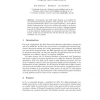87 search results - page 16 / 18 » Ciphers Secure against Related-Key Attacks |
108
click to vote
CARDIS
1998
Springer
15 years 3 months ago
1998
Springer
We proposed a new block cipher, Serpent, as a candidate for the Advanced Encryption Standard. This algorithm uses a new structure that simultaneously allows a more rapid avalanche,...
103
click to vote
CHES
2010
Springer
15 years 22 days ago
2010
Springer
The need for lightweight (that is, compact, low-power, low-energy) cryptographic hash functions has been repeatedly expressed by application designers, notably for implementing RFI...
ASIACRYPT
2010
Springer
14 years 9 months ago
2010
Springer
Abstract. AES is the most widely used block cipher today, and its security is one of the most important issues in cryptanalysis. After 13 years of analysis, related-key attacks wer...
IVC
2006
14 years 11 months ago
2006
In recent years, the chaos based cryptographic algorithms have suggested some new and efficient ways to develop secure image encryption techniques.Inthis communication,weproposea ...
EUROCRYPT
2009
Springer
16 years 6 days ago
2009
Springer
A weak pseudorandom function (wPRF) is a cryptographic primitive similar to ? but weaker than ? a pseudorandom function: for wPRFs one only requires that the output is pseudorandom...

